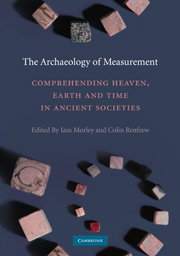Book contents
- Frontmatter
- Contents
- List of figures and tables
- List of contributors
- Acknowledgements
- The Archaeology of Measurement
- Introduction: Measure: Towards the construction of our world
- SECTION I NUMBER: COUNTING, MATHEMATICS AND MEASURE
- SECTION II MATERIALISING THE ECONOMY
- SECTION III DIMENSIONS AND BELIEF
- SECTION IV CALENDAR AND COSMOLOGY
- 14 The measurement of time and distance in the heavens above Mesopotamia, with brief reference made to other ancient astral sciences
- 15 Evolution of the calendar in Shang China
- 16 The measure of time in Mesoamerica: From Teotihuacan to the Maya
- 17 Measuring time, sacred space, and social place in the Inca Empire
- 18 Measuring time in the European Neolithic? The function and meaning of Central European circular enclosures
- SECTION V THE SPIRITUALITY OF MEASURE
- Index
- References
15 - Evolution of the calendar in Shang China
Published online by Cambridge University Press: 05 June 2012
- Frontmatter
- Contents
- List of figures and tables
- List of contributors
- Acknowledgements
- The Archaeology of Measurement
- Introduction: Measure: Towards the construction of our world
- SECTION I NUMBER: COUNTING, MATHEMATICS AND MEASURE
- SECTION II MATERIALISING THE ECONOMY
- SECTION III DIMENSIONS AND BELIEF
- SECTION IV CALENDAR AND COSMOLOGY
- 14 The measurement of time and distance in the heavens above Mesopotamia, with brief reference made to other ancient astral sciences
- 15 Evolution of the calendar in Shang China
- 16 The measure of time in Mesoamerica: From Teotihuacan to the Maya
- 17 Measuring time, sacred space, and social place in the Inca Empire
- 18 Measuring time in the European Neolithic? The function and meaning of Central European circular enclosures
- SECTION V THE SPIRITUALITY OF MEASURE
- Index
- References
Summary
The calendar(s) employed by the earliest known Chinese state, the Shang (ca. 1600–1044 BC), have been tentatively reconstructed from the divinatory inscriptions carved on bovine scapulae and tortoise plastrons. The calendar is woven into these inscriptions because they are all dated, and the forms and content of dating evolve over the few centuries in which the inscriptions were made (roughly 1300–1050 BC). These materials show the close interconnection of the measurement of time not only with divinations but with a broader range of ritual practice organized around the ancestral cult. They also present an interesting case in which we can observe the interplay among the calendar as a liturgical schedule, the calendar as a mode of divination, and the calendar as a measure of the cycle of lunations and solar seasons. In this chapter I will briefly sketch what the inscriptions reveal about the origins of the calendar in China and about the enduring impact of those origins on the uses of calendars and time measurement in Chinese civilization.
The earliest method of measuring and recording time in the inscriptions employs the sexagesimal cycle formed by the sequential and synchronized enumeration of a cycle of 10 graphs (later called the ‘celestial trunks’ [tian gan]: jia, yi, bing, ding, wu, ji, geng, xin, ren, gui) and another cycle of 12 graphs (later called the ‘earthly branches’ [di zhi]: zi, chou, yin, mou, chen, si, wu, wei, shen, you, shu, hai).
- Type
- Chapter
- Information
- The Archaeology of MeasurementComprehending Heaven, Earth and Time in Ancient Societies, pp. 195 - 202Publisher: Cambridge University PressPrint publication year: 2010
References
- 1
- Cited by



